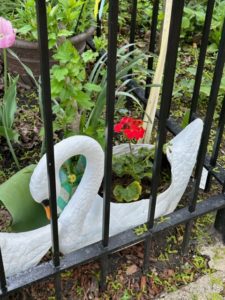 I greet most days by walking in my neighborhood with my dog.
I greet most days by walking in my neighborhood with my dog.
She likes the routine. I do, too.
I love to watch her sniff trees and examine discarded fast food wrappers. In all probability, we walked past the very same locations a couple days earlier.
Nothing we come across is a surprise, but when I walk with my dog, the moment feels fresh and new.
One morning this week, we passed a front yard garden behind a six-foot high wrought iron fence. I had lingered there before but don’t recall being so struck by its swan-shaped planters. Each planter in the flock of three contained a single red bloom.
The image made me think about fairy tales.
Folk tales and myths, full of magic and mystery, before Disney streamed them into our living rooms, were told and re-told.
Parents, grandparents and babysitters added their own twists. Adults took their recollections of foundational stories into adulthood. People developed their own favorites.
Cinderella is supposed to be the most widely recognized fairy tale. The French version, Cendrillon, penned in the late seventeenth century by Charles Perrault, had a lot of time to build a following.
“Beauty and the Beast,” “Snow White,” “Sleeping Beauty,” “Little Red Riding Hood” — there are so many fairy tales. They don‘t all start “Once Upon a time,” and end “… and they lived happily ever after.”
In a fairy tale, goodness usually triumphs over evil, yet casualties often occur. In an early rendering, “The Little Mermaid” turns into sea foam at the end. In his story, Tom Thumb dies of a spider bite.
There’s a long-standing tradition of telling fairy tales to young children as a way to impart moral instruction.
“Beauty and the Beast” reminds us to look beyond physical attributes and value internal qualities of character. In “Snow White,” we’re led to consider the joy in having purpose and community. In “Sleeping Beauty,” we’re reminded that true love can endure and even prove stronger than bad intentions.
When I was growing up, I loved the story of Cinderella. I wasn’t raised by a wicked stepmother, but I wasn’t my mother’s favorite and often felt in service to my family regardless of its toll on my sense of self. I didn’t feel seen.
When I looked at the swan planters, I also thought about the “Ugly Duckling.” Not that I felt odd-looking, but, and I’m sure other people can relate to this, I didn’t feel I belonged to the family I was born into.
Much of my adult life has been about creating family-like relationships outside of the circle of people with whom I shared an address. It seems like it should be an easier thing to do, but the pull of biology in our culture is like gravity. It’s hard not to want to feel seen by people who have known you all your life.
Years ago, I read “Women Who Run with the Wolves,” by Jungian scholar, Clarissa Pinkola Estes, an analysis of myths and fairy tales as they relate to the wild woman archetype.
It’s an exploration of connecting with that part of you that is naturally free and confident, self-possessed and trusting of your own understanding.
I thought about the purpose of fairy tales to provide moral instruction to children. I felt sad about what I perceive as a faulty understanding of happiness fairy tales convey.
I suppose stories require plots and conflict and complications, but the genre places so much emphasis on pursuing future conditions and not enough about the joy of being present to the moment.
By thinking “if I only meet my prince,” or “kill the evil queen” or “return to the land of my ancestors,” it’s easy to lose sight of the blessings in front of you NOW.
I thought of this as I stared through the fence, simply enjoying a neighbor’s front lawn fantasy.
French poet and philosopher Paul Valery said, “The best way to make your dream come true is to wake up.”
Knowing that happiness is not a reward for enduring hardship or a permanent “ever after” state but is to be experienced moment by moment is no small thing.


I love that quote “The best way to make your dream come true is to wake up.”